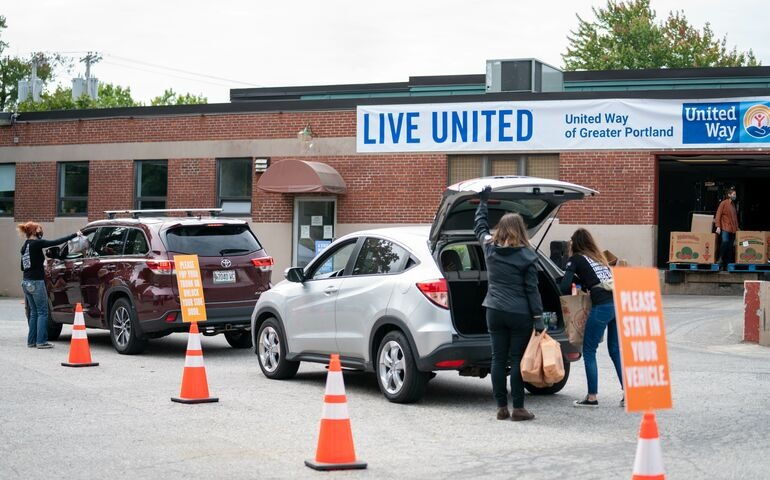
Processing Your Payment
Please do not leave this page until complete. This can take a few moments.
- News
-
Editions
View Digital Editions
Biweekly Issues
- December 15, 2025
- December 1, 2025
- Nov. 17, 2025
- November 03, 2025
- October 20, 2025
- October 6, 2025
- + More
Special Editions
- Lists
- Viewpoints
-
Our Events
Event Info
Award Honorees
- Calendar
- Biz Marketplace
More than 40% of households in most Maine counties struggle to afford basics
 Courtesy / AMANDA KOWOLSKI
Nearly all of Maine’s 16 counties — 13 — had 40% or more households unable to make ends meet in 2021. United Way of Greater Portland held a drive-thru food drive that year at Wayside Food Programs in Portland.
Courtesy / AMANDA KOWOLSKI
Nearly all of Maine’s 16 counties — 13 — had 40% or more households unable to make ends meet in 2021. United Way of Greater Portland held a drive-thru food drive that year at Wayside Food Programs in Portland.
Households in nearly every Maine county have recently had trouble making ends meet despite earning a paycheck, a new study finds.
In 13 of the 16 counties, 40% or more of the households faced difficulty covering the basic costs of living during 2021, according to the study, which reviewed not only households that fall under federal poverty level guidelines but also those that had individuals who were employed but had limited assets and income constraints.
The report was released last week by the United Way chapters of Maine in partnership with United For ALICE, a U.S. research organization driving innovation, research and action to improve life across the country for people in financial hardship.
In Kennebec County, for example, a total of 16,230 households fell into what United Way calls the ALICE population. Those were households earning more than the official U.S. poverty level, but less than the basic cost of living. ALICE stands for Asset Limited, Income Constrained, Employed.
The number was more than double the poverty rate, which accounted for 6,600 households in Kennebec County.
Combined, ALICE households and households in poverty fell below the ALICE Threshold of Financial Survival and accounted for 42% of all households in Kennebec County.
Typical residents falling into the ALICE category include college graduates unable to afford to live on their own, young families strapped by child care costs and mid-career professionals now underemployed.
“These folks are vital to our state’s future economic well-being, and they face barriers beyond their control — hindering their ability to become financially stable,” said United Way of Kennebec Valley's president and CEO Courtney Yeager.

“ALICE in Maine: A Study of Financial Hardship” spotlighted the population that works at low-paying jobs, have little or no savings and are one emergency away from falling into poverty.
The report is the most comprehensive depiction of financial need in the state to date, according to a news release. It uses the latest data from a variety of sources, including the U.S. Census.
Metrics are based on 2021 income levels and expenses and quantify how many in Maine’s workforce are struggling financially.
County-by-county
ALICE Reports provide county-by-county data and analysis of how many households are struggling, including the obstacles ALICE households face on the road to financial independence
Households below the ALICE Threshold span all races, ages and genders. Yet for certain groups, the struggle is disproportionate. For example, 59% of Black and 44% of Hispanic households in Maine were below the ALICE Threshold in 2021, compared to 41% of white households.
Because wages had stagnated for a decade, 34% of the state’s 17,820 retail sales workers lived below the ALICE Threshold in 2021.
The 13 counties where 40% or more households were unable to make ends meet were:
- Aroostook 46%
- Franklin 45%
- Hancock 41%
- Knox 44%
- Lincoln 45%
- Oxford 52%
- Penobscot 44%
- Piscataquis 49%
- Somerset 49%
- Washington 51%
- York 40%
The average income needed to survive in Maine depends on local conditions and ranged from $64,444 to $80,760 annually for a family of four, more than double the official U.S. poverty level.
Even with the temporary pandemic supports that were available, in 2021, a family of four with two-full time workers earning salaries as a retail salesperson and a cashier — two of the most common occupations in Maine — fell short of affording their basic expenses by $12,688.
The cost of household basics are much higher than the federal poverty level suggests. The According to the report, a household “survival” budget — housing, child care, food, transportation, health care and technology, plus taxes — for a family of four in Kennebec County in 2021 was $64,944, well above the federal poverty level of $26,500.
In 2019, 19,484 households in Kennebec County were below the ALICE threshold; in 2021, this number changed to 22,830, a 17% increase.
“It's staggering to note that from 2019 to 2021, Kennebec County had a 17% increase in households below the ALICE threshold — and that was the second highest increase of all Maine counties," Yeager said.
Policy implications
The data have implications for policymakers, the report says.
The consumer price index forms the basis for many aspects of public policy, but it conceals actual increases in the cost of household basics, which diminishes the reach and effectiveness of policy and results in tangible hardship for recipients of public program benefits, the report says.
This is especially true for the programs most relevant to ALICE households, including inflation strategy; tax brackets and credits; the annual increase of benefits in a range of programs from Social Security to pensions for veterans and civil servants; and the annual increase of the federal poverty level as well as programs with eligibility based on the federal poverty level, like SNAP and Medicaid, the report says.
“Inflation in Maine has long contributed to a structural economic problem: Wages for jobs essential to the running of the economy are not high enough for workers to afford the household basics they need to support their families,” the report says.
The report says its essentials tracking better aligns wages with the basic cost of living.
“By increasing the accuracy of data on hardship, these ALICE measures are designed to help lift all boats: Improving conditions for ALICE families will in turn fuel economic growth, benefiting all households, communities, and businesses in the state,” the report says.
The ALICE Report for Maine was funded in part by the John T. Gorman Foundation.
Mainebiz web partners
Related Content

The Giving Guide
The Giving Guide helps nonprofits have the opportunity to showcase and differentiate their organizations so that businesses better understand how they can contribute to a nonprofit’s mission and work.
Learn More
Work for ME
Work for ME is a workforce development tool to help Maine’s employers target Maine’s emerging workforce. Work for ME highlights each industry, its impact on Maine’s economy, the jobs available to entry-level workers, the training and education needed to get a career started.
Learn More
Groundbreaking Maine
Whether you’re a developer, financer, architect, or industry enthusiast, Groundbreaking Maine is crafted to be your go-to source for valuable insights in Maine’s real estate and construction community.
Learn more-
The Giving Guide
The Giving Guide helps nonprofits have the opportunity to showcase and differentiate their organizations so that businesses better understand how they can contribute to a nonprofit’s mission and work.
-
Work for ME
Work for ME is a workforce development tool to help Maine’s employers target Maine’s emerging workforce. Work for ME highlights each industry, its impact on Maine’s economy, the jobs available to entry-level workers, the training and education needed to get a career started.
-
Groundbreaking Maine
Whether you’re a developer, financer, architect, or industry enthusiast, Groundbreaking Maine is crafted to be your go-to source for valuable insights in Maine’s real estate and construction community.
ABOUT
NEW ENGLAND BUSINESS MEDIA SITES
No articles left
Get access now
In order to use this feature, we need some information from you. You can also login or register for a free account.
By clicking submit you are agreeing to our cookie usage and Privacy Policy
Already have an account? Login
Already have an account? Login
Want to create an account? Register
Get access now
In order to use this feature, we need some information from you. You can also login or register for a free account.
By clicking submit you are agreeing to our cookie usage and Privacy Policy
Already have an account? Login
Already have an account? Login
Want to create an account? Register











0 Comments